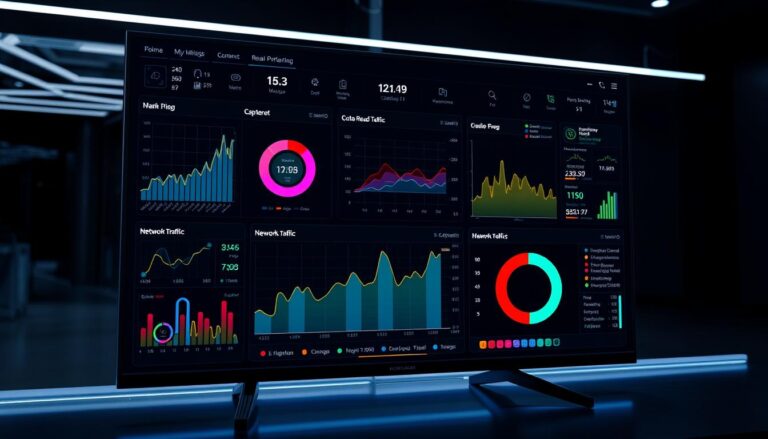Supply chain management software is changing the game in today’s competitive world. It makes logistics more efficient and reliable. These tools help simplify complex processes, ensuring products get to customers on time. They use data and flexible strategies to tackle current challenges, starting a new chapter in supply chain management.
Studies by Gartner predict a future where supply chains work on their own. Technologies like AI, IoT, and blockchain are merging with traditional logistics software. This combo creates a strong network, improving how decisions are made. For example, IBM’s Sterling Supply Chain Business Network helped Labatt Canada cut down on errors, while Lenovo became more agile thanks to IBM Supply Chain Insights. Also, NetSuite’s AI tools highlight how these solutions can change supply chains for the better.
The COVID-19 pandemic has shown how vital these modern tools are. Inventory issues and questioning supplier reliability have pushed for quicker adoption of this software. The abilities to forecast, automate, and see operations clearly not only help bounce back but also build strength. This matches the ever-changing world of business today.
Key Takeaways
- Supply chain management software is pivotal in driving efficiencies and catering to heightened customer expectations.
- Technology, including AI, IoT, and blockchain, is revolutionizing the logistics landscape.
- Big names like IBM and NetSuite are at the forefront, offering insights and operational excellence.
- The capacity to adapt to disruptions like the COVID-19 pandemic highlights the importance of robust software solutions.
- Real-time data and automation are integral to maintaining a competitive, resilient, and sustainable supply chain.
- Investing in supply chain optimization through software leads to significant improvements in decision-making, efficiency, and cost management.
Understanding Supply Chain Optimization
Thriving industries stand on optimized supply chains. This includes better management, sustainability in supply chains, and meeting customer needs. A well-planned supply chain has a big impact.
Improving operations breaks down barriers. This increases clarity and strength against market changes. Good supply chain management cuts costs, boosts efficiency, and helps in making smart choices.
The Importance of Successful Supply Chains
Strong supply chains use new tech and smart ways to lower purchase and storage costs. This helps in saving money and improving services. Keeping the right amount of stock cuts extra costs. Also, strong supply chains follow rules and are better for the planet.
Key Challenges in Supply Chain Management
Supply chain management faces tough challenges like data silos, changing customer needs, and the push for speed and green practices. Companies must use real-time data and predictive tools. This helps plan for demand and smooth out operations. It lowers risks and keeps goods and info moving well, meeting customer needs.
Optimization is a constant effort that needs constant review and use of new tech. This builds a strong, flexible supply chain. Companies aim for efficiency, green practices, and meeting customer wants as they manage supply chains.
Types of Software Solutions for Supply Chain
Modern logistics heavily rely on advanced software to manage complexity. Enterprise Resource Planning systems (ERP), Transportation Management Systems (TMS), and Warehouse Management Software (WMS) are key. They boost operational efficiency and quick responses.
Enterprise Resource Planning (ERP) Systems
ERP systems merge many business functions into one system. This makes processes and info flow better across the organization. Solutions like ERP software, SAP ERP, and Microsoft Dynamics 365 help in various areas. They assist in production, finances, and customer relations to support strategic choices and better operations.
Transportation Management System (TMS)
TMS makes moving goods more efficient, cutting transportation costs and improving services. By using systems like SAP TM and Oracle Transportation Management, companies manage route plans, freight, and shipments. This ensures products are delivered on time.
Warehouse Management Systems (WMS)
WMS aids in everyday warehouse operations. They help businesses keep optimal inventory levels and organize product storage and retrieval. They also make order processes smoother. Systems like Oracle NetSuite and Manhattan Active Warehouse support not just warehousing but complex logistics too.

Using these powerful software solutions brings big improvements in supply chain metrics. The benefits include better inventory accuracy and happier customers thanks to punctual deliveries. Employing specialized Enterprise Resource Planning systems, Transportation Management Systems, and Warehouse Management Software helps businesses stay competitive in today’s fast market.
Benefits of Implementing Software Solutions
Investing in advanced software for supply chain management boosts efficiency and cuts costs. It also makes everything more transparent. By using these technologies, companies move towards their goals faster and more effectively.
Enhanced Visibility and Control
Adding supply chain management software brings big advantages. It offers enhanced transparency in the supply chain. Companies can see what’s happening in real-time. This helps catch problems early and make smart choices.
It keeps things running smoothly and efficiently. Using IoT and blockchain adds to this transparency. They provide a clear record of all transactions and movements.
Improved Efficiency and Cost Reduction
Software solutions make supply chains work better. They automate tasks like managing inventory and processing orders. This leads to reduced operational costs. Also, AI helps match supply with demand smarter, reducing waste.
These tools help supply chains stay lean and fast. They adapt quickly to new market conditions. This keeps them ahead of the competition and increases profits.
Smart supply chain systems change the game. They lower costs and make supply chains more responsive and tough. This means happier customers and more successful businesses.
Key Features to Look for in Supply Chain Software
Companies face a tough journey managing supply chains. The right software features are critical. They not only boost operations but also help businesses stay competitive in shifting markets.
Real-time Data Analytics
Real-time data analytics in supply chain software is a game-changer. It lets companies watch their operations closely and act quickly. This feature improves demand forecasting, boosts inventory management, and raises customer satisfaction by offering insights into the supply chain.
Integration Capabilities
Integration capabilities in software are key for a unified supply chain. Good software easily blends with existing ERP systems, logistics, and other tools. This creates a connected setup that boosts visibility and workflow.
User-friendly Interfaces
User-friendly software is vital for smooth supply chain operations. An easy interface cuts down on training, reduces mistakes, and simplifies access to essential functions. This makes handling complex tasks easier for everyone.

Supply chain software should also include advanced analytics. These offer deep insights into logistics and partnerships. Artificial intelligence and machine learning lead to smarter, data-driven choices.
When companies focus on these key features, they pick software that fits well today and grows with them tomorrow. This approach prepares businesses for future shifts in the supply chain world.
The Role of Automation in Supply Chain Optimization
Industries today are turning to automation in supply chain as a key way to boost efficiency and toughness. Automation helps make supply chain processes smoother and reduces mistakes. These improvements help companies stay ahead in the competitive market.
Streamlining Processes with Automation
Automation changes the game in supply chain management. By using Robotic Process Automation (RPA) and Intelligent Document Processing (IDP), businesses boost productivity by up to 35%. These tools handle tasks like updating inventory and planning the best routes for shipping fast and accurately, making manual checks less needed.
Reducing Errors and Enhancing Productivity
Automation’s accuracy cuts down errors in supply chains. Warehouse automation can improve stock accuracy by 20-30%, helping avoid delays and extra costs. Plus, it slashes operational costs by 30% in logistics, showcasing how it ramps up business efficiency.
About 73% of supply chain professionals see automation as key to staying competitive. They expect a 45% increase in its use in logistics in the next five years. Automation not only hits immediate goals but also supports long-term strategies. It speeds up deliveries, meeting customer expectations, and makes organizations more adaptable to change.
In the face of labor shortages and events like the Suez Canal blockage, automation stands as a solid plan B. It keeps operations going even with fewer workers or unexpected issues. So, supply chains can stay efficient, no matter what happens in the world.
Therefore, automation’s role in improving and optimizing supply chain processes is vital. It ensures operations run smoothly, aids in handling challenges, and keeps companies competitive.
Implementation Strategies for Supply Chain Software
Implementing supply chain software effectively is key for boosting efficiency and saving costs in today’s business world. The demand for supply chain management software is expected to grow significantly. This is because companies are investing in sophisticated software to stay competitive.
We will concentrate on two vital areas: Assessing Organizational Needs and Training Staff for Effective Usage. These steps are crucial for making the most out of supply chain software strategies.
Assessing Organizational Needs
The first step is to identify what your organization really needs from the software. It involves examining your supply chain processes closely and spotting where improvements are needed. Choosing technologies like those that helped Procter & Gamble cut shipping costs is smart. These technologies use predictive analytics and machine learning to boost efficiency.
Training Staff for Effective Usage
After selecting the right software, teaching your staff how to use it is essential. Offering detailed training helps employees use the software well, getting you more value from your investment. Encouraging ongoing learning and development can also make your team better at adopting new technology.
The table below outlines the key considerations and expected outcomes when implementing supply chain software:
| Consideration | Expected Outcome |
|---|---|
| Organizational Need Assessment | Tailored software solutions enhancing specific operational efficiencies |
| Training and Development | High proficiency in software usage, leading to improved supply chain performance |
| Technology Adoption | Incorporation of AI and predictive analytics for data-driven decision making |
| Projected Market Growth | Expanding from 28.9 billion USD to 45.2 billion USD by 2027 |
The way supply chain software is implemented is crucial to industry-wide transformations. Erbis’s experience shows us that custom solutions and advanced technologies like AI, IoT, and blockchain greatly improve supply chain visibility and efficiency.
Case Studies of Successful Software Integration
Looking into real-world cases shows the huge impact of good software integration in supply chains. Leading companies have shown that the right approach can fix common issues. It also makes the supply chain work better overall.
Examples from Leading Companies
IBM’s journey with its cognitive supply chain stands out. It uses IBM Watson technology. This has saved a lot of money and improved decision-making. Cognitive capabilities let staff talk to the system in everyday language. This makes things faster and easier. Even during the COVID-19 pandemic, IBM kept up a 100% order fulfillment rate. This proves their system’s strength and efficiency.
Amazon is another big name that uses smart tech like AI and robots to manage its global supply chain. With tools for predicting and handling data, Amazon works with impressive speed. It runs hundreds of fulfillment centers around the world.
Lessons Learned from Implementation Challenges
The path to good software integration in supply chains has obstacles but teaches us a lot. A major lesson is the value of being adaptable and always improving. For example, 48% of supply chain bosses have struggled with old systems, says a report from Deloitte. This shows the need for flexible systems that work well with the old ones.
Also, using IoT technology can cut costs by up to 30%, according to McKinsey and the International Data Corporation. But this also brings up the need for strong security and smart ways to handle lots of instant data.
In the end, these case studies don’t just show how software integration can change things. They also highlight the usual troubles. They give a guide for businesses wanting to use tech to make their supply chains stronger and more efficient.
Future Trends in Supply Chain Optimization Software
The supply chain world is changing fast, with artificial intelligence in supply chains leading the way. There’s also a big focus on making supply chain software more sustainable. Studies like the BME Logistics Study 2024 show that many companies are behind on risk management. Only 31% are happy with how they manage risks. This shows a big need for smarter solutions.
The Impact of Artificial Intelligence
Adding AI to supply chains makes them more efficient and precise. Take REMIRA’s AI Forecasting Service, for example. It uses lots of data to better predict demand, avoiding too much or too little stock. We’re seeing more AI, like GenAI, deep learning, and NLP, being used to quickly process complicated information. This helps people work together better and manage inventory more effectively.
Technologies like REMIRA’s blend smoothly into existing setups, making supply chains both quick and sturdy. A report from KPMG predicts that by 2026, 30% of businesses will automate half of their network tasks. It shows how fast AI is being adopted.
Sustainability in Supply Chain Software Solutions
The supply chain sector is moving towards being more eco-friendly and responsible. Software like REMIRA’s not only boosts sales forecasts and buying but also helps the planet. It reduces waste, cuts carbon footprints, and makes supplier checks clearer. Businesses are starting to see how grouping orders can lead to fewer deliveries and less CO2.
This shift is driven by what customers want and growing corporate social responsibility. The movement towards sustainable supply chain software is shaping the future. It’s not just a trend. It’s about making money while taking good care of our resources.
FAQ
What are the primary benefits of using software solutions for supply chain optimization?
Software solutions for supply chain optimization offer several benefits. These include better operational efficiency, lower costs, and enhanced transparency. They also improve demand forecasting, streamline processes, and automate tasks.
How can supply chain management software improve efficiency in operations?
Supply chain management software boosts operational efficiency by automating parts of the supply chain. This includes managing inventory, procurement, and warehousing. It reduces manual errors and optimizes logistics.
What are the key challenges in implementing supply chain software solutions?
Challenges in implementing supply chain software include integrating with existing systems and overcoming data silos. Organizations also face the task of managing change and training staff. Aligning software capabilities with business goals is crucial.
What features should businesses look for when selecting supply chain management software?
When choosing supply chain management software, businesses should seek features like real-time analytics and integration capabilities. User-friendly interfaces and automation are key. Advanced features may also include AI and machine learning.
What role does an Enterprise Resource Planning (ERP) system play in supply chain optimization?
An ERP system is crucial for supply chain optimization. It offers a centralized platform for managing financial and operations data. This includes strategic forecasting and efficient resource planning.
In what ways does a Transportation Management System (TMS) enhance supply chain operations?
A Transportation Management System (TMS) enhances supply chain operations by optimizing routes and freight auditing. It manages carriers and ensures compliance with shipping regulations. This reduces shipping costs and improves delivery reliability.
How do Warehouse Management Systems (WMS) contribute to supply chain effectiveness?
Warehouse Management Systems (WMS) contribute to supply chain effectiveness by automating warehouse processes. They improve inventory accuracy and optimize storage space. This reduces order processing times, crucial for quick market response.
Can supply chain optimization software support sustainability initiatives?
Yes, supply chain software supports sustainability through efficient resource management and waste reduction. It enhances energy efficiency and supports responsible sourcing. Improving supply chain visibility makes it easier to adopt eco-friendly practices.
How does automation within supply chain management increase productivity?
Automation in supply chain management boosts productivity by handling repetitive tasks. It allows professionals to focus on strategic decisions. This improves accuracy and speeds up processes, reducing errors.
What are some notable case studies of companies successfully implementing supply chain software?
Companies like Anheuser-Busch and Lenovo have successfully used IBM Sterling Supply Chain Business Network. This has improved visibility, anomaly detection, and risk management. Their experience highlights operational improvements and quick disruption response.
How significant is staff training when implementing new supply chain management software?
Staff training is vital when introducing new supply chain management software. It ensures employees effectively use the system’s features. Proper training boosts adoption rates and improves overall supply chain performance.
What are future trends in supply chain optimization software?
Future trends in supply chain software include using artificial intelligence for improved demand forecasting. Technologies like blockchain and IoT will offer better traceability. A focus on sustainability and exploring digital twins are also on the horizon.



